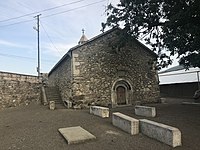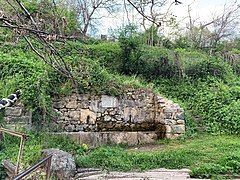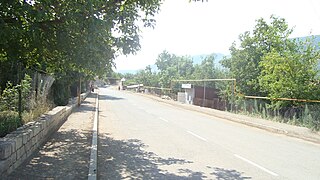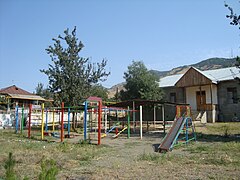Hadrut
Hadrut
Հադրութ | |
|---|---|
Town | |
 General view of Hadrut | |
 Hadrut | |
| Coordinates: 39°31′00″N 47°01′48″E / 39.51667°N 47.03000°ECoordinates: 39°31′00″N 47°01′48″E / 39.51667°N 47.03000°E | |
| Country
Claimed | |
| District | Khojavend |
| Elevation | 720 m (2,360 ft) |
| Population (2015)[1] | |
| • Total | 4,100 |
| Time zone | UTC+4 (UTC) |
Hadrut (![]() listen (help·info); Armenian: Հադրութ, romanized: Hadrut' or Armenian: Գետահատ, romanized: Getahat) is a town in the Khojavend District of Azerbaijan. The town had an ethnic Armenian-majority population prior to the 2020 Nagorno-Karabakh war.[2]
listen (help·info); Armenian: Հադրութ, romanized: Hadrut' or Armenian: Գետահատ, romanized: Getahat) is a town in the Khojavend District of Azerbaijan. The town had an ethnic Armenian-majority population prior to the 2020 Nagorno-Karabakh war.[2]
Etymology[]
The name Hadrut is of Persian origin, and means "between two rivers". This is explained by the fact that the older part of the settlement was located between two streams, Guney-chay and Guzey-chay. Hadrut later expanded beyond the two rivers to the east and west.[3][4]
History[]

The date of Hadrut's foundation is unknown. Fragments of monuments and historical artifacts dated to pre-Christian, early Christian and medieval times have been found in and around Hadrut. There are several ruins of ancient fortresses and walls in the valley surrounding Hadrut. From medieval times until the early 19th century, Hadrut was a part of the Armenian Principality of Dizak, one of the five Melikdoms of Karabakh.[4] In the 15th and 16th century, many of the fortifications, churches and settlements around Hadrut were destroyed by Ottoman and Safavid forces as they fought for control of the South Caucasus. A small number of these structures were rebuilt under the rule of the meliks of Dizak.[4] The Melikdom of Dizak was subordinated to the Karabakh Khanate before the Russian conquest of Karabakh.[citation needed]
During the Russian period, Hadrut was governed as part of different administrative divisions: first as a part of Karabakh Province (1822-1840), then Shusha Uyezd of Caspian Oblast (1840-1846), Shusha Uzeyd of Shamakhi Governorate (1846-1859), Shusha Uyezd of Baku Governorate (1859-1868), Shusha Uzeyd of Elisabethpol Governorate (1868-1873) and Dzhebrail Uyezd of Elisabethpol Governorate (1873-1917) successively.
In the Soviet period, Hadrut became the centre of the Hadrut District of the Nagorno-Karabakh Autonomous Oblast within Azerbaijan SSR. Some of the earliest activities of the Karabakh movement occurred in Hadrut, beginning with the collection of petitions in 1986 for the transfer of the Nagorno-Karabakh Autonomous Oblast to the Armenian SSR and culminating in a demonstration of one thousand people in Hadrut in February 1988, which then spread to the capital of the NKAO, Stepanakert.[5] Following the Armenian victory and establishment of de facto independence in the First Nagorno-Karabakh War, it became centre of the Hadrut Province of the Republic of Artsakh.

In the midst of the 2020 Nagorno-Karabakh conflict, heavy fighting took place in Hadrut, marked by the usage of cluster munitions by the Azerbaijani Army.[6] Azerbaijan captured Hadrut on or around 9 October 2020.[7][8] Although most of the civilian population was evacuated, Armenian authorities reported that a number of civilians were killed in Hadrut and the surrounding area during or after the battle.[9][10][11] Following the battle, a video of an execution of two Armenian men in the town by Azerbaijani soldiers spread online, prompting investigations.[12][13]
The town was vandalized and looted by Azerbaijani soldiers after its capture, with people's belongings strewn throughout the streets and the contents of homes upturned. The Armenian cemetery of the town's church was vandalized as well, with its gravestones having been kicked down and smashed.[14] In January 2021, as part of the reconstruction work in Hadrut, new Azerbaijani-language street signs were erected in Hadrut with new street names based on the names of fallen Azerbaijani soldiers and historical Azerbaijani personalities.[15] In June 2021, Azerbaijani authorities installed an "Iron Fist" monument in the town to celebrate the outcome of the 2020 war.[16]
Population[]
The earliest recorded census of the town of Hadrut showed a population of around 2,400 registered inhabitants in 1939, of which more than 90% was Armenian.[17] Hadrut kept an Armenian-majority population throughout the First Nagorno-Karabakh war[2] up to the Second Nagorno-Karabakh war, during which the town was captured by Azerbaijani forces and the Armenian population was expelled.
| Year | Armenians | Azerbaijanis | Russians | Ukrainians | Total | ||||
|---|---|---|---|---|---|---|---|---|---|
| 1939[17] | 2,200 | 91.4% | 51 | 2.1% | 129 | 5.4% | 22 | 0.9% | 2,408 |
| 1970[18] | 1,845 | 88.6% | 137 | 6.6% | 68 | 3.3% | 18 | 0.9% | 2,082 |
| 1979[19] | 1,955 | 90.0% | 188 | 8.7% | 19 | 0.9% | 2 | 0.1% | 2,173 |
| 2005[20] | 2,936 | 100% | 2,936 | ||||||
| 2015[21] | 3,102 | 100% | 3,102 | ||||||
| October 2020: Capture by Azerbaijani forces. Expulsion of Armenian population | |||||||||
Economy[]
The town was home to the Mika-Hadrut Winery, which produced brandy, vodka, and wine.[22]
Gallery[]
The center of Hadrut
Scenery
Street
View of Hadrut streets
A hotel in Hadrut

Water spring in Hadrut
Playground

Hadrut regional hospital
Climate[]
Hadrut has a cold semi-arid climate (BSk) according to the Köppen climate classification.
| hideClimate data for Hadrut | |||||||||||||
|---|---|---|---|---|---|---|---|---|---|---|---|---|---|
| Month | Jan | Feb | Mar | Apr | May | Jun | Jul | Aug | Sep | Oct | Nov | Dec | Year |
| Average high °C (°F) | 4.5 (40.1) |
5.4 (41.7) |
9.2 (48.6) |
16.4 (61.5) |
20.2 (68.4) |
25.2 (77.4) |
28.3 (82.9) |
29.2 (84.6) |
23.7 (74.7) |
18.3 (64.9) |
11.6 (52.9) |
7.1 (44.8) |
16.6 (61.9) |
| Average low °C (°F) | −2.9 (26.8) |
−2.3 (27.9) |
0.8 (33.4) |
6.5 (43.7) |
10.8 (51.4) |
14.9 (58.8) |
18.0 (64.4) |
16.9 (62.4) |
13.9 (57.0) |
8.8 (47.8) |
3.7 (38.7) |
−0.4 (31.3) |
7.4 (45.3) |
| Average precipitation mm (inches) | 22 (0.9) |
28 (1.1) |
42 (1.7) |
54 (2.1) |
79 (3.1) |
59 (2.3) |
25 (1.0) |
24 (0.9) |
31 (1.2) |
44 (1.7) |
34 (1.3) |
23 (0.9) |
465 (18.2) |
| Source: http://en.climate-data.org/location/52897/ | |||||||||||||
International relations[]
When the town was under Armenian control, Hadrut was twinned with the following cities:
 Vagarshapat, Armenia (2010–2020)[23]
Vagarshapat, Armenia (2010–2020)[23] Burbank, United States (2014–2020)[24]
Burbank, United States (2014–2020)[24]
References[]
- ^ National Statistical Service Of The Nagorno Karabakh Republic - Nagorno-Karabakh In Figures (2015)
- ^ Jump up to: a b Андрей Зубов. "Андрей Зубов. Карабах: Мир и Война". drugoivzgliad.com.
- ^ Davidbekov, I. (1888). "Село Гадрут Елисаветпольской губернии Джебраильского уезда". Сборник материалов для описания местностей и племён Кавказа. Вып. 6 [Collection of materials for the description of localities and tribes of the Caucasus․ 6th ed.] (in Russian). Tiflis. p. 150.
- ^ Jump up to: a b c Mkrtchyan, Shahen (1980). "Հադրութի ձորակի հուշարձանները [Monuments of Hadrut valley]". Լեռնային Ղարաբաղի պատմա-ճարտարապետական հուշարձանները [The historical-architectural monuments of Mountainous Karabakh] (PDF) (in Armenian). Yerevan: Hayastan publishing house. pp. 91–95.
- ^ Hakobyan, Tatul (2010). Karabakh Diary: Green and Black: Neither War Nor Peace. Antelias, Lebanon. pp. 23–25. ISBN 978-9953-0-1816-4.
- ^ "Azerbaijan: Cluster Munitions Used in Nagorno-Karabakh". Human Rights Watch. 2020-10-23. Retrieved 2020-11-22.
- ^ "President of Azerbaijan: 'Hadrut settlement and several villages liberated from occupation'". APA.az. 9 October 2020. Archived from the original on 10 October 2020. Retrieved 9 October 2020.
Azerbaijan's Hadrut settlement and several villages were liberated from Armenian aggressors, President Ilham Aliyev said this in his address to the nation, APA reports.
- ^ "Azerbaijani MoD shows soldiers who liberated Hadrut from Armenian occupation (PHOTO)". Trend.Az. 2020-10-19. Retrieved 2020-11-14.
- ^ "Artsakh Ombudsman: The Azerbaijani actions aiming at deepening humanitarian disaster in Artsakh, causing 20 casualties, 93 wounded and over 5800 material losses". Aysor.am. 8 October 2020. Retrieved 18 October 2020.
- ^ "The Azerbaijani Side Has Killed At Least Five Civilians since the Ceasefire Came into Force". Aysor.am. 8 October 2020. Retrieved 18 October 2020.
- ^ "At least 5 civilians killed by Azerbaijan in Artsakh following ceasefire". armenpress.am. 11 October 2020. Retrieved 6 January 2021.
- ^ "An Execution in Hadrut". Bellingcat. Retrieved 2020-10-16.
- ^ Atanesian, Grigor; Strick, Benjamin (24 October 2020). "Nagorno-Karabakh conflict: 'Execution' video prompts war crime probe". BBC News. Retrieved 5 January 2021.
- ^ "Uneasy peace takes hold in contested region of Azerbaijan". PBS NewsHour. 2020-11-30.
- ^ Ali, Samir (2021-01-08). "Signs and plates with street names being put up in Azerbaijan's Hadrut (PHOTOS)". MENAFN - Trend News Agency.
- ^ Məmmədov, www mrsadiq info | Sadiq; Məmmədov, www mrsadiq info | Sadiq (2021-06-26). "Azerbaijan erects "Iron Fist" monument in liberated Hadrut (PHOTO)". News.az. Retrieved 2021-08-20.
- ^ Jump up to: a b Result of the Soviet census of 1939 of the Hadrut district "/Census Hadrut (in Russian)".
- ^ "Гадрутский район 1970". www.ethno-kavkaz.narod.ru. Retrieved 2021-02-10.
- ^ "Result of the Soviet census of 1979 of the Hadrut district". www.ethno-kavkaz.narod.ru. Retrieved 2021-02-10.
- ^ De facto and De Jure Population by Administrative Territorial Distribution and Sex Archived 2011-03-02 at the Wayback Machine Census in NKR, 2005. THE NATIONAL STATISTICAL SERVICE OF NAGORNO-KARABAKH REPUBLIC
- ^ "Table 1.6 NKR urban and rural settlements grouping according to de jure population number" (PDF). stat-nkr.am. Population Census 2015. Archived from the original (PDF) on 7 March 2020.
- ^ "Mika-Hadrut at Spyur IS". Spyur.am. Retrieved 2020-10-13.
- ^ "HADRUT". Էջմիածնի քաղաքապետարանի պաշտոնական կայք (Website of the City of Vagarshapat). Retrieved 2020-10-15.
- ^ "Նորություններ - yerkir.am" [Hadrut (NKR) and Burbank (USA) have become sister cities]. www.yerkir.am. Retrieved 2020-10-15.
External links[]
| Wikimedia Commons has media related to Hadrut. |
- Populated places in Hadrut province
- Populated places in Khojavend District
- Nagorno-Karabakh











